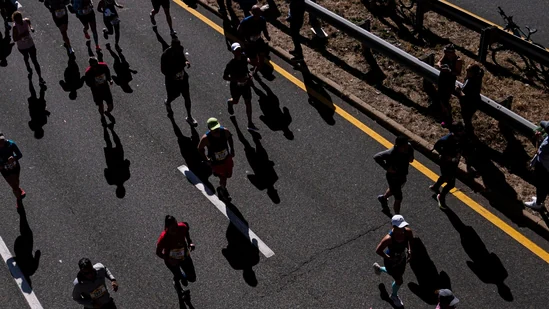Surge in doping cases hurts Kenya's reputation as distance-running hub
In 2012, a German documentary made a sensational disclosure of rampant doping among Kenyan long-distance runners. It led to a series of accusations from Kenya that has dominated middle and long-distance running like no other country, breaking numerous records. So much so that the genetic capability of Kenyan runners, their physique and training in rough terrain have become a matter of intrigue and research. High-altitude training in the African nation is considered vital for their dominant distance running.  PREMIUM
PREMIUM
While Kenyan athletes are still winning races worldwide, they are now being seen with suspicion. In the last few years, especially this season, there has been an alarming rise is doping cases (more than 25 positive cases in last 12 months) among Kenyan athletes. among Kenyan runners. The World Anti-Doping Agency has kept a close watch on Kenyan athletes. This season, the Athletics Integrity Unit–an independent body of World Athletics that fights doping–has led a crackdown on Kenyan runners, resulting in a number of positive cases in the last 12 months. It includes some big names like Diana Kipyokei, 2021 Boston Marathon winner, Philemon Kacheran, best known as Eliud Kipchoge’s training partner, who was dropped from the Kenyan team for the Commonwealth Games in Birmingham.
In a recent interview, Brett Clothier, head of AIU, termed the doping scene in Kenya “serious.”
"Certainly, there is no getting around that there is lot of doping in Kenya. It is a serious issue and a very serious moment for Kenyan athletics. We with our partners are doing our best but there is lot more to be done,” Clothier told Kenyan television (NTV). “We work very well with Kenya anti-doping agency, but frankly they need more resources to fight this battle. That’s the next level of this fight."
The world so far has watched Kenyan runners in awe and wondered how to beat them. Their endurance levels have been exemplary.
“One always talked about the genetic factor when it came to Kenyan domination. Nobody paid attention to them because they were so good. So, when a few athletes first got caught for doping, there was this thought that even they resort to unfair means,” says Amrish Kumar, the long-distance coach who shaped the career of Avinash Sable.
“If they are so good, why are they taking advantage of doping? We don’t know since how many years it has been going on. They are Olympic and world champions and have all the records. They wanted more. In fact, it is not only the athletes but big sponsors, foreign coaches who want records, prize money,” says Kumar.
Running is a source of livelihood in Kenya, an escape from the drudgery of farm life. Winning international races attracts big prize money. It is considered a lucrative business. Despite Kenya criminalising the use of banned drugs as part of its Anti-Doping Act of 2016, it is widely prevalent now.
In many recent cases, Kenyan athletes have been charged with tampering and furnishing false documents.
In 2013, in the aftermath of the German documentary, Kenya had appointed a taskforce to investigate the allegations against Kenyan athletes and make recommendations.
The taskforce report slammed Athletics Kenya and said many of the coaches, administrators and athletes who appeared before it pointed an accusing finger at the foreign player agents as major sources of supplying prohibited substances to athletes.
“AK has failed over the years, firstly, to reach athletes at the grassroots levels with education on anti-doping, and secondly, to effectively control the influx of agents into the country. Two conclusions flow from these findings. There is need for an elaborate programme of education and awareness that should reach all those participating in sports, including those at school. Secondly, there is a need to regulate the operations of foreign agents and coaches. In short, their significance to Kenya’s sport needs to be reconsidered,” it noted.
In December 2016, WADA and AIU launched a project to examine doping practices of Kenyan athletes. According to the findings, between 2004 and 1 August, 2018 a total of 138 Kenyan athletes (across sports) had tested positive for prohibited substances. Distance running was the most tested sport in Kenya, accounting for nearly 91% (8945 out of 9885) of all tests conducted and 74% (1602 out of 2167) of all athletes tested. “Distance running has produced more AAFs (adverse analytical findings) than all other Kenyan sports combined and accounts for 95% (131 of 138) of all AAFs,” according to the 2016 WADA report.
It also noted that nandrolone, an anabolic-androgenic that promotes power and muscle strength, and erythropoietin (EPO) that stimulates red blood cell production and improves cardiovascular endurance, were the two banned substances most used by Kenyan athletes.
That trend seems to be changing now as recent cases indicate. Triamcinolone acetonide, a drug that helps athletes lose weight without suffering significant loss in power, has also been found in samples of those caught.
Ten Kenyan athletes tested positive for that substance between 2021 and 2022, according to AIU.
“Within the same time period in athletics globally, there have been just two positive triamcinolone acetonide AAFs for athletes from all other countries. In the four years from 2017 to 2020, there were only three Kenyan AAFs for triamcinolone acetonide. In addition to the Kipyokei, Lempus and Kangogo cases, AIU currently has four open investigations into AAFs for triamcinolone acetonide for Kenyan athletes; with two matters pending with ADAK,” AIU said.
Experience unrestricted digital access with HT Premium
Explore amazing offers on HT + Economist Start 14 Days Free Trial Already Subscribed? Sign In
Disclaimer: The copyright of this article belongs to the original author. Reposting this article is solely for the purpose of information dissemination and does not constitute any investment advice. If there is any infringement, please contact us immediately. We will make corrections or deletions as necessary. Thank you.







